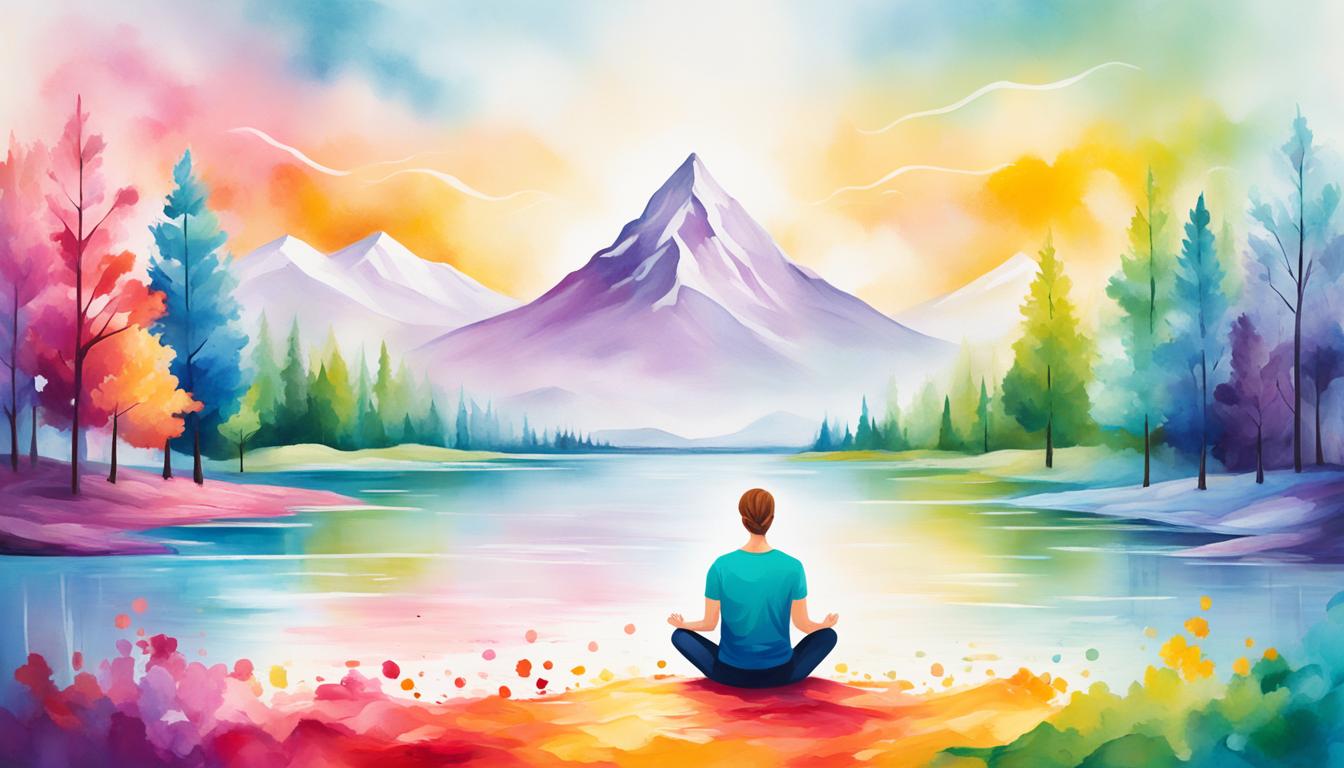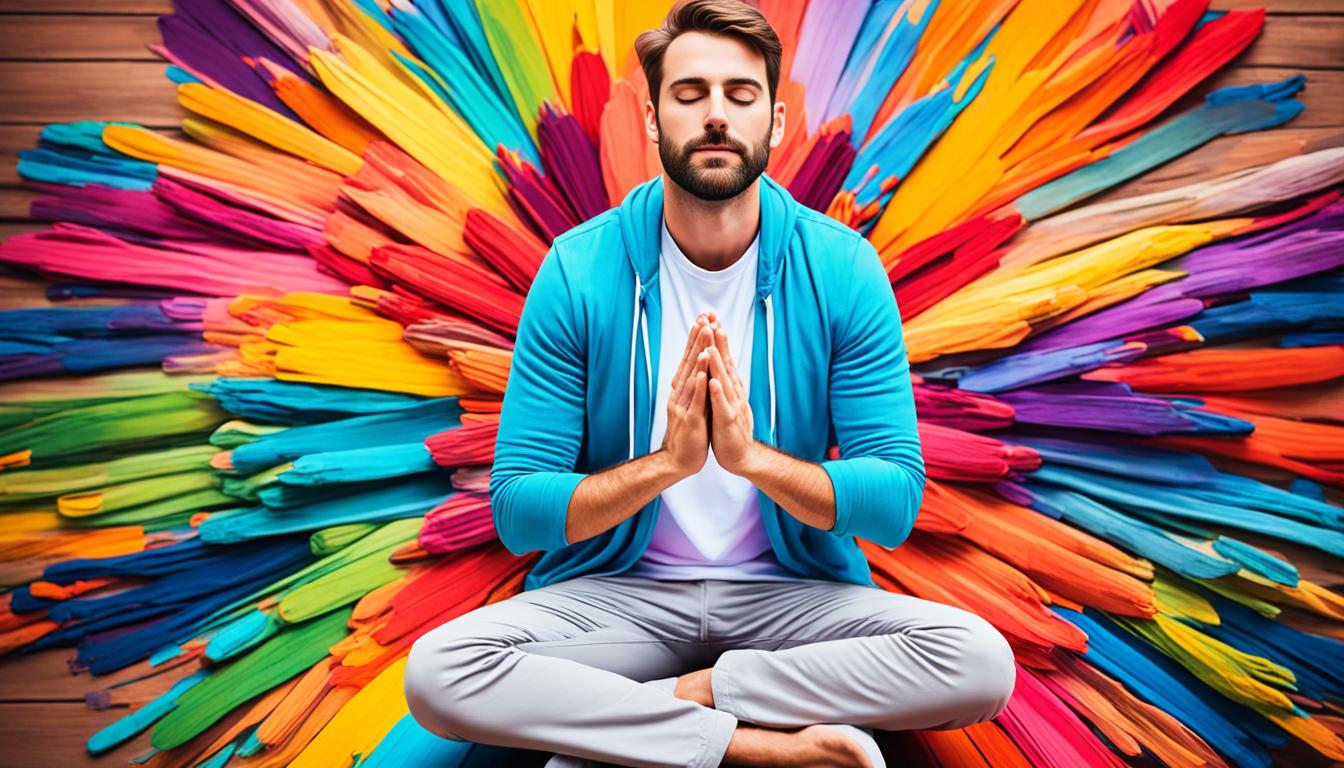Discover the transformative power of color meditation, a relaxation technique that can bring peace and balance to your mind and body. Color meditation combines the principles of mindfulness practice, visualization methods, and the psychology of colors to create a serene and calming experience.
In our fast-paced and stressful lives, finding moments of relaxation and inner peace is essential for our mental health and well-being. Color meditation offers a unique approach to achieving these states by harnessing the power of colors. By immersing yourself in the soothing hues and understanding the impact they have on our emotions, you can experience profound stress relief and emotional balance.
Key Takeaways:
- Color meditation combines mindfulness practice, visualization methods, and the psychology of colors.
- By immersing yourself in soothing hues, you can experience stress relief and emotional balance.
- Understanding the impact of colors on our emotions can help create a serene environment.
- Color meditation promotes relaxation, mindfulness, and inner peace.
- Explore the world of color meditation and discover the transformative power of colors in enhancing your well-being.
Understanding the Psychology of Colors
Color psychology is a fascinating field that explores how colors influence human behavior, emotions, and the subconscious mind. Through a combination of scientific research, cultural beliefs, and personal experiences, experts have discovered the profound impact that colors have on our daily lives. By understanding the psychology of colors, we can harness their power to enhance various aspects of our lives, from marketing and branding to interior design and personal well-being.

Scientific research has shown that different colors have the ability to stimulate specific areas of our brain, triggering emotional and physiological responses. For example, warm colors like red and orange tend to evoke feelings of energy, passion, and enthusiasm. On the other hand, cool colors such as blue and green have a calming effect on our nervous system, promoting relaxation and serenity.
“Colors are not just visually pleasing but also hold immense power over our emotions and actions.” – Dr. Jane Anderson, Color Psychologist
Cultural beliefs also play a significant role in color psychology. For centuries, societies have associated certain colors with specific meanings and emotions. For example, the color red is often associated with love and passion in Western cultures, while it symbolizes luck and prosperity in many Asian cultures. These cultural associations further highlight how colors can influence our thoughts and behaviors.
Furthermore, our personal experiences with colors contribute to our individual perceptions and emotional responses. For instance, a person who had a positive experience in a blue-hued environment may associate the color blue with feelings of calmness and tranquility. Similarly, someone who had a negative experience with a specific color may develop aversions or negative emotions towards that color in the future.
By understanding color psychology, we can make informed decisions when it comes to utilizing colors in our daily lives. Whether it’s choosing the right colors for a brand’s logo to evoke specific emotions or designing a calming space in our homes using soothing colors, color psychology offers valuable insights for achieving our desired outcomes.
Applying Color Psychology to Personal Well-being
One area where color psychology has gained significant attention is personal well-being and mental health. Many individuals have found solace and relaxation through color meditation, which involves focusing on specific colors to promote emotional balance and inner peace. By incorporating colors that resonate with our emotions and personal experiences, we can create an environment that fosters a sense of tranquility and well-being.
In the next section, we will explore the science behind color psychology and how different colors can influence our emotions and contribute to a calm and serene atmosphere.
The Science Behind Color Psychology
Colors have a profound influence on our emotions and can significantly impact our well-being. Understanding the science behind color psychology can empower us to create environments that evoke specific moods and promote a sense of overall well-being.
Warm colors like red and orange have the power to raise our energy levels and ignite passion and enthusiasm within us. These colors stimulate and excite, creating a sense of vitality and stimulation. When surrounded by warm colors, we can experience a surge of energy and a heightened sense of enthusiasm.
On the other hand, cool colors like blue and green have a calming effect on our nervous system. These colors induce a sense of relaxation, tranquility, and serenity. Blue is often associated with the vastness of the sky and the calming presence of water, promoting a peaceful and serene atmosphere. Green, being a color abundant in nature, creates a connection to the earth and promotes a sense of harmony and balance.
By incorporating warm colors into our environment, we can create a space that energizes and stimulates us. These colors are ideal for areas where we want to feel motivated and passionate, such as a home office or a fitness room. Alternatively, cool colors can create an atmosphere of calm and peace, making them suitable for bedrooms, meditation spaces, and areas dedicated to relaxation.

By recognizing the power of colors and their impact on our emotions, we can intentionally choose hues that align with our desired energy levels and mood. Whether it’s the fiery energy of red or the soothing serenity of blue, colors provide us with a powerful tool to shape our surroundings and enhance our overall well-being.
How Colors Influence Our Emotions
Colors have a profound impact on our emotions and can evoke a wide range of feelings. One color that is often associated with serenity and peace is blue. Its calming effect can help reduce anxiety and promote a sense of calmness. Imagine a peaceful blue sky or the tranquil ocean waves gently washing ashore, bringing a sense of serenity to your mind and body.
Another color that holds great significance in promoting emotional well-being is green. As the color of nature, green represents harmony and balance. Spending time in nature or simply surrounding yourself with green hues can restore your energy and provide a feeling of renewal and revitalization.

In addition to blue and green, earth tones such as browns and beiges also play a vital role in influencing our emotions. These warm, earthy colors convey a sense of warmth and stability, creating a cozy and comforting environment that promotes relaxation and emotional well-being.
By incorporating these colors into our surroundings, we can create a peaceful atmosphere that fosters a deep sense of tranquility and connection to nature. Whether it’s painting your walls in soothing earth tones, adding green plants to your space, or simply surrounding yourself with objects that evoke a feeling of peace and stability, the power of color in influencing our emotions cannot be understated. Embrace the harmony and balance that blue, green, and earth tones bring to your life and discover the serenity they can provide.
The Calming Influence of Colors
Certain colors have a soothing effect on our minds and bodies. Blue, symbolizing vastness and tranquility, has a natural way of slowing down our heart rate and reducing stress levels.
According to scientific research, the color blue has been found to lower blood pressure and promote better sleep. So, incorporating hints of blue into your surroundings, whether through artwork, decor, or even a relaxing blue color scheme for your bedroom, can contribute to a more serene and peaceful atmosphere, helping you achieve better sleep and a sense of tranquility.
Similarly, green, with its connection to nature and growth, has a calming effect on our nervous system. It induces relaxation and rejuvenation, bringing a sense of harmony and balance to our daily lives. Spending time in natural environments, surrounded by lush greenery, can have a rejuvenating effect, helping to reduce stress levels and promote overall well-being.

Furthermore, incorporating earth tones into your surroundings can have a grounding effect, fostering a sense of stability and security. Earth tones encompass a range of colors, such as browns and beiges, which create a warm and comforting environment. By incorporating these soothing colors into your home or workspace, you can create a serene atmosphere that promotes relaxation and inner peace.
Applying Color Psychology in Everyday Life
Incorporating color psychology into your daily life can significantly enhance stress management and create a calm and serene environment. By understanding the power of calming colors and their impact on our emotions, you can reduce anxiety and promote a sense of tranquility throughout your day.
Start by surrounding yourself with calming colors in your home décor. Choose soft and soothing hues like blues, greens, and earth tones to create a peaceful atmosphere. Opt for calming wall colors, such as a refreshing light blue or a serene sage green, to evoke feelings of relaxation and tranquility.
Additionally, consider the colors you wear. Clothing colors can influence your mood and emotions. By selecting calming colors for your outfits, you can create a sense of tranquility and inner peace wherever you go. Choose soft pastels or cool blues and greens to promote a sense of calmness and serenity.

Colors also play a significant role in therapy, such as color therapy or chromotherapy. Color therapy utilizes specific colors to balance energy and promote holistic healing. By incorporating color therapy into your wellness routine, you can harness the power of colors to restore balance and promote relaxation.
Experience the benefits of color meditation by embracing color psychology in your everyday life. Create a serene environment with calming colors in your home décor and clothing choices. Explore the world of therapy through color therapy and discover the positive impact it can have on your overall well-being. Let the power of colors guide you towards stress management and a more tranquil life.
The Role of Colors in Therapy
Color therapy, also known as chromotherapy, utilizes the power of colors to balance our energy and promote holistic healing. Each color corresponds to specific energetic vibrations, and by exposing ourselves to these colors, we can restore harmony and balance to our mind, body, and spirit.
One of the key aspects of color therapy is its ability to bring our energy centers, also known as chakras, into alignment. These energy centers play a vital role in our overall well-being, and by incorporating color therapy into our spiritual practices, such as meditation, visualization, or simply surrounding ourselves with specific colors, we can enhance our relaxation and well-being.

“Color therapy has the potential to significantly impact our mental, emotional, and physical well-being. It has been used for centuries as a spiritual practice that promotes relaxation and healing.”
Color therapy, as a holistic approach to healing, has shown positive results for numerous individuals. Reduced stress and anxiety, improved sleep, increased focus, and a general sense of overall well-being are some of the reported benefits.
By embracing the power of colors in therapy, we harness their ability to tap into our emotional, spiritual, and energetic realms. Through color therapy, we can experience profound relaxation, enhanced self-awareness, and a deeper connection to our inner selves. It is a truly transformative practice that contributes to our holistic well-being.
Conclusion
Color meditation is a powerful technique that can significantly enhance your relaxation, mindfulness, and emotional well-being. By harnessing the calming influence of colors and understanding their impact on our psychology, you can create environments that evoke specific emotions and promote tranquility in your daily life.
Whether you choose to incorporate soothing colors in your surroundings or consciously select calming colors for your clothing, color meditation offers a practical pathway to finding inner peace and achieving a state of calmness. You can also explore the potential of color therapy, or chromotherapy, as a holistic approach to healing and promoting overall well-being.
Take a moment to embrace the world of color meditation and discover the transformative power of colors in enhancing your emotional well-being. By immersing yourself in the soothing realms of color, you can unlock a sense of profound tranquility and experience the benefits of stress relief, mindfulness, and inner peace.
FAQ
What is color meditation?
Color meditation is a relaxation technique that incorporates colors to enhance mindfulness and achieve tranquility.
How does color psychology influence our emotions?
Color psychology combines scientific research, cultural beliefs, and personal experiences to understand how different colors stimulate specific areas of our brain, triggering emotional and physiological responses.
Which colors have a calming effect on our nervous system?
Cool colors like blue and green have a calming effect on our nervous system, inducing relaxation and tranquility.
What emotions are associated with blue and green?
Blue is often associated with serenity and peace, while green represents harmony and balance.
How do soothing colors like blue and green impact our well-being?
Blue has a natural way of slowing down our heart rate, reducing stress levels, and promoting better sleep. Green has a calming effect on our nervous system, inducing relaxation and rejuvenation.
How can I apply color psychology in my daily life?
By surrounding yourself with calming colors in your clothing choices and home décor, you can reduce anxiety and promote a sense of tranquility. Color therapy, such as chromotherapy, can also be utilized for holistic healing.
What is color therapy?
Color therapy, also known as chromotherapy, uses colors to balance energy and promote holistic healing. It involves exposing oneself to specific colors that correspond to energetic vibrations to restore balance and harmony.
How can color meditation benefit my well-being?
Color meditation offers a pathway to finding inner peace and achieving a state of calm. By harnessing the calming influence of colors, you can create environments that evoke specific emotions and promote relaxation and emotional well-being.
Source Links
- https://www.pinterest.com/ideas/meditation-colors/904680814055/
- https://endeavor.moffitt.org/archive/color-your-world-to-relieve-stress
- https://www.aurahealth.io/blog/discover-the-calming-power-of-colors


